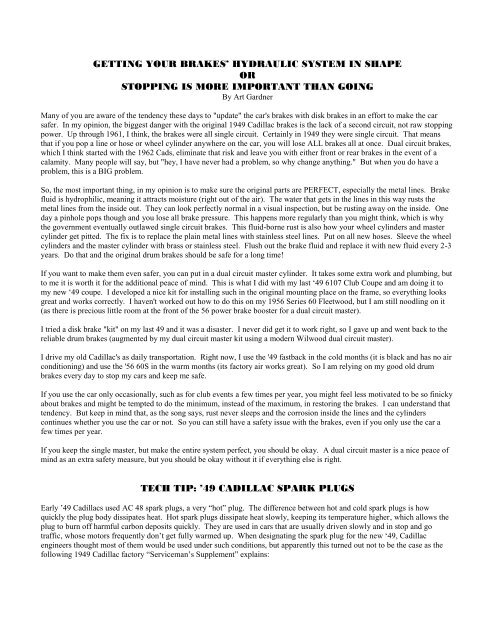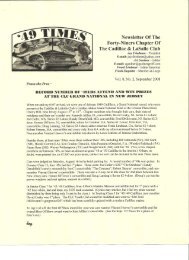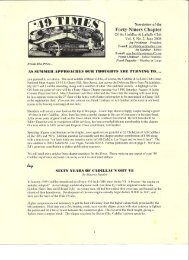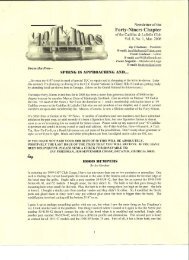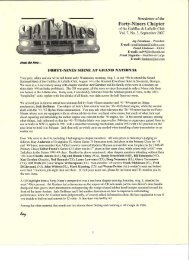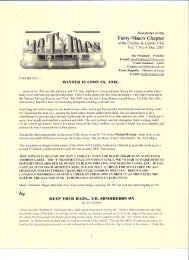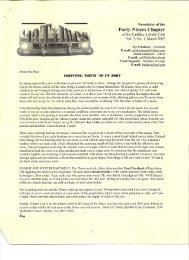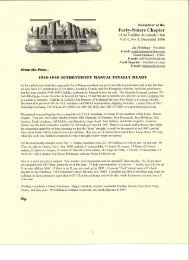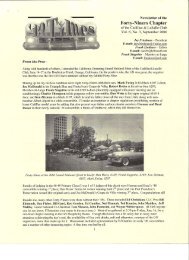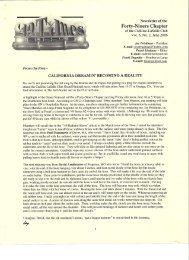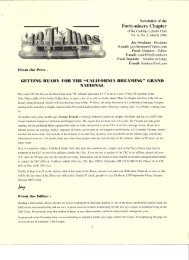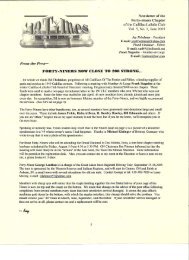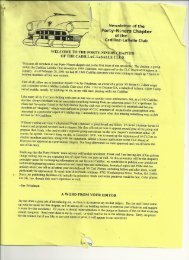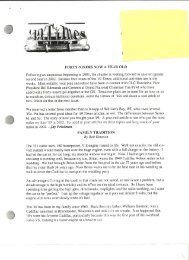Create successful ePaper yourself
Turn your PDF publications into a flip-book with our unique Google optimized e-Paper software.
GETTING YOUR BRAKES’ HYDRAULIC SYSTEM IN SHAPE<br />
OR<br />
STOPPING IS MORE IMPORTANT THAN GOING<br />
By Art Gardner<br />
Many of you are aware of the tendency these days to "update" the car's brakes with disk brakes in an effort to make the car<br />
safer. In my opinion, the biggest danger with the original 1949 Cadillac brakes is the lack of a second circuit, not raw stopping<br />
power. Up through 1961, I think, the brakes were all single circuit. Certainly in 1949 they were single circuit. That means<br />
that if you pop a line or hose or wheel cylinder anywhere on the car, you will lose ALL brakes all at once. Dual circuit brakes,<br />
which I think started with the 1962 Cads, eliminate that risk and leave you with either front or rear brakes in the event of a<br />
calamity. Many people will say, but "hey, I have never had a problem, so why change anything." But when you do have a<br />
problem, this is a BIG problem.<br />
So, the most important thing, in my opinion is to make sure the original parts are PERFECT, especially the metal lines. Brake<br />
fluid is hydrophilic, meaning it attracts moisture (right out of the air). The water that gets in the lines in this way rusts the<br />
metal lines from the inside out. They can look perfectly normal in a visual inspection, but be rusting away on the inside. One<br />
day a pinhole pops though and you lose all brake pressure. This happens more regularly than you might think, which is why<br />
the government eventually outlawed single circuit brakes. This fluid-borne rust is also how your wheel cylinders and master<br />
cylinder get pitted. The fix is to replace the plain metal lines with stainless steel lines. Put on all new hoses. Sleeve the wheel<br />
cylinders and the master cylinder with brass or stainless steel. Flush out the brake fluid and replace it with new fluid every 2-3<br />
years. Do that and the original drum brakes should be safe for a long time!<br />
If you want to make them even safer, you can put in a dual circuit master cylinder. It takes some extra work and plumbing, but<br />
to me it is worth it for the additional peace of mind. This is what I did with my last „49 6107 Club Coupe and am doing it to<br />
my new „49 coupe. I developed a nice kit for installing such in the original mounting place on the frame, so everything looks<br />
great and works correctly. I haven't worked out how to do this on my 1956 Series 60 Fleetwood, but I am still noodling on it<br />
(as there is precious little room at the front of the 56 power brake booster for a dual circuit master).<br />
I tried a disk brake "kit" on my last 49 and it was a disaster. I never did get it to work right, so I gave up and went back to the<br />
reliable drum brakes (augmented by my dual circuit master kit using a modern Wilwood dual circuit master).<br />
I drive my old Cadillac's as daily transportation. Right now, I use the '49 fastback in the cold months (it is black and has no air<br />
conditioning) and use the '56 60S in the warm months (its factory air works great). So I am relying on my good old drum<br />
brakes every day to stop my cars and keep me safe.<br />
If you use the car only occasionally, such as for club events a few times per year, you might feel less motivated to be so finicky<br />
about brakes and might be tempted to do the minimum, instead of the maximum, in restoring the brakes. I can understand that<br />
tendency. But keep in mind that, as the song says, rust never sleeps and the corrosion inside the lines and the cylinders<br />
continues whether you use the car or not. So you can still have a safety issue with the brakes, even if you only use the car a<br />
few times per year.<br />
If you keep the single master, but make the entire system perfect, you should be okay. A dual circuit master is a nice peace of<br />
mind as an extra safety measure, but you should be okay without it if everything else is right.<br />
TECH TIP: ’49 CADILLAC SPARK PLUGS<br />
Early ‟49 Cadillacs used AC 48 spark plugs, a very “hot” plug. The difference between hot and cold spark plugs is how<br />
quickly the plug body dissipates heat. Hot spark plugs dissipate heat slowly, keeping its temperature higher, which allows the<br />
plug to burn off harmful carbon deposits quickly. They are used in cars that are usually driven slowly and in stop and go<br />
traffic, whose motors frequently don‟t get fully warmed up. When designating the spark plug for the new „49, Cadillac<br />
engineers thought most of them would be used under such conditions, but apparently this turned out not to be the case as the<br />
following 1949 Cadillac factory “Serviceman‟s Supplement” explains:


